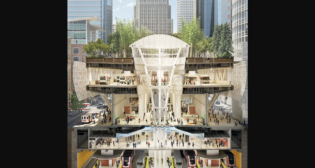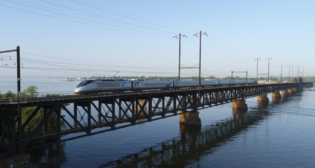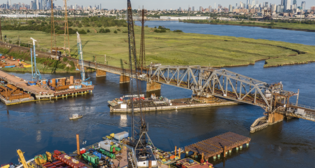
Will safety investments to protect railroads, public increase CBR costs?
Written by William C. Vantuono, Editor-in-ChiefIn an unusual flurry of regulatory and stock market activity on the first day of business in 2014, the U.S. Pipeline and Hazardous Materials Safety Administration (PHMSA) on January 2 issued a safety alert warning “that the type of crude oil being transported from the Bakken region may be more flammable than traditional heavy crude oil.”
Shares in the largest owner of Bakken drilling rights, Continental Resources, fell 4.2% upon the news, showing that financial markets anticipate an eventual end to the free-for-all loading of untested Bakken crude into older tank cars long judged by safety boards in the U.S. and Canada to be not-fit-for-purpose.
That would be of some relief for railroads and crews who have been the first unwitting victims in a potentially fatal deception in which oilfield loaders mix crude from various sources into tank cars without testing the resulting blend and then hand inaccurate shipping documents to train conductors. That was indeed the case in the July 6 inferno that took 47 lives at Lac-Mégantic, Quebec.
Canada’s Transportation Safety Board said that the Lac-Mégantic crude had been mis-classified as low-risk. Lawyers for the Montreal, Maine & Atlantic and its locomotive engineer will argue that accurate knowledge of the cargo’s explosive nature would have changed the way the MM&A and local first responders managed the train after a locomotive fire and subsequent shutdown led to a slow discharge of brake pressure and an unmanned runaway train. By systematically mis-classifying high-volatility Bakken oil as the lowest-risk crude, shippers can employ North America’s ubiquitous fleet of low-pressure DOT-111 tank cars rather than more secure high-pressure cars approved for explosive liquids. There are simply not enough high-pressure cars available for the booming CBR business, and there is as yet no new government-approved tank car design to replace older DOT-111, even though the industry has been building stronger, safer cars under voluntary standards developed by the Association of American Railroads and carbuilders since October 2011.
Oil companies, car lessors, and fuel brokers own the huge fleet of DOT-111 cars and are resisting rapid retirement of the cars, despite evidence that many of them are rotting from the inside due to the exceptionally corrosive nature of at least some Bakken crude.
Even as the Federal Railroad Administration and PHMSA finally move to protect railroads and crews, public and political questioning will now shift to why these agencies have not upgraded tank car specifications and have not ensured that crude shippers respect existing hazmat law. Each time either agency issues a fresh safety alert, it exposes its own laxity in enforcing laws passed by Congress.
Last spring, before Lac-Mégantic, the judicial Federal Energy Regulatory Commission found that extraordinary concentrations of hydrogen sulfide in some Bakken crude was endangering the health and safety of pipeline workers and gave operators the right to refuse it. The finding did not apply to rail terminal operators or railroads and the H2S-contaminated crude was in all likelihood diverted to rail.
Unlike pipelines, railroads do not test the crude they are offered for carriage, relying on the veracity of the documentation provided at the loading terminals. The PHMSA alert contains its strongest imperative yet that Bakken crude be tested before shipment and, significantly, that dangerous gases such as H2S be removed before loading into tank cars.
“Based upon preliminary inspections conducted after recent rail derailments in North Dakota, Alabama, and Lac-Mégantic, Quebec involving Bakken crude oil, PHMSA is reinforcing the requirement to properly test, characterize, classify, and where appropriate, sufficiently degasify hazardous materials prior to and during transportation,” reads the PHMSA alert.
Some oil industry experts speculate that Bakken crude, initially assayed to be exceptionally sweet, is being soured by the formation of H2S generated by microbes inadvertently introduced with the water and chemicals injected to increase flow through the shale.
The PHMSA Safety Alert says that even stricter testing requirements are being developed. That will be an onerous burden at the loading terminals, where virtually no testing is taking place at present. Loading terminal operators will have to add substantial infrastructure and personnel to draw samples from each car and analyze them before trains are handed over to railroads.
With new requirements on the way, terminal operators cannot yet know the extent of testing that will eventually be required, but were ordered by the PHMSA to proceed immediately with existing test requirements.
Expensive facilities to remove H2S and other explosive gases will also be required. This would have to be done before crude is loaded, complicating the existing practice of co-mingling oil from a variety of well sources in holding tanks before loading into tank cars.
With no east-west pipelines existing or proposed, rail is the only option for coastal refiners wanting to substitute Bakken oil for crude imported by sea. The now inescapable reality is that massive investment will be required in tank cars, testing facilities, and de-gasification plants.
That will certainly disrupt CBR, but it will not stop it. Oil shippers and buyers will bear the costs. Railroads will benefit by better protection for trains, tracks, and crews, and perhaps some relief from the unfair blame they accrue if an oil train explodes.



